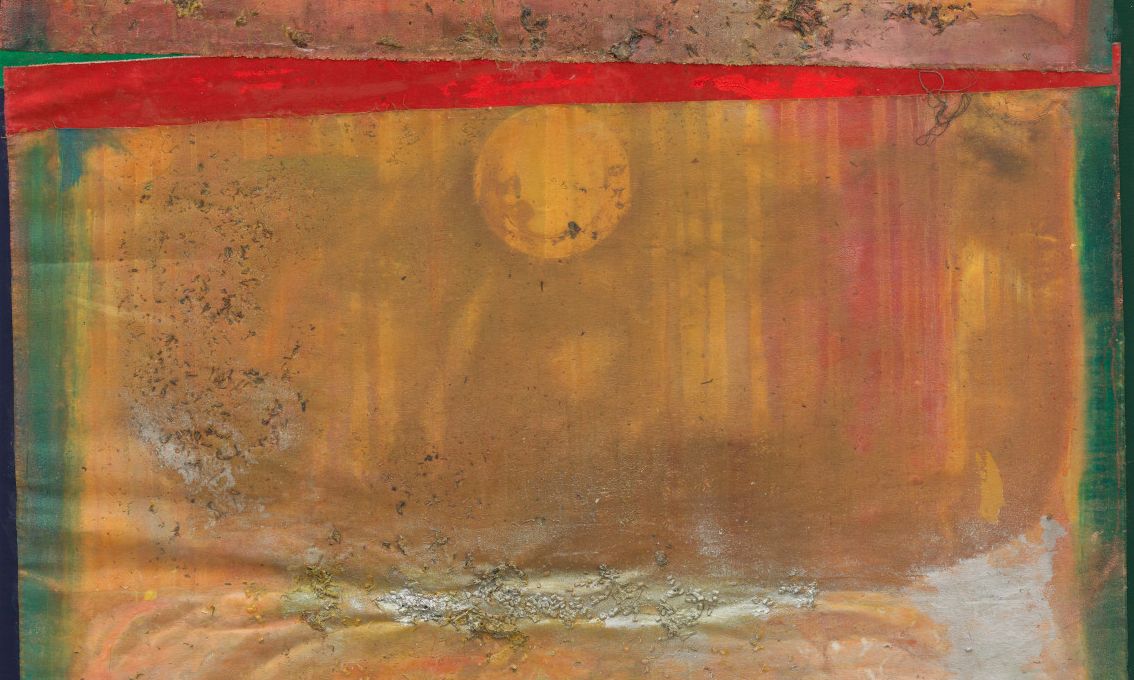Frank Bowling's Passtheball (2022)
Courtesy of Gagosian and the artist
Every decade or so, the art world likes to declare that either figurative painting or abstract painting is dead. As the British painter and critic Wyndham Lewis wrote in The New Republic in 1940: “At last the Cube, the Cone, the Cylinder are still forever. They will never again stalk the streets of Paris. The Equilateral Triangle has breathed its last. Braque’s abstract bric-a-brac is fast becoming junk. The most amusing collage will fetch nothing in Europe. Brancusi’s Egg has gone to join the Dodos.”
But, while abstract art has indeed fallen in and out of fashion over the past 100 years, a group show of more than 40 artists opening across two of Gagosian’s London galleries in June shows how the movement—or movements—are gaining momentum once again, as the current Whitechapel Gallery exhibition of female abstractionists, Action, Gesture, Paint, also pays testament.
“Abstract art is very much alive, it’s far from dead,” says Gary Garrels, the US-based curator of the show. “What I’ve found is that we’re at a moment of extraordinary diversity—there’s no single approach, there’s no single movement. Instead we have extraordinarily strong artists, each approaching issues of abstraction in their own way with their own voice.”
Curator Gary Garrels
Photo: Andria Lo
Gagosian gave “carte blanche” to Garrels to select artists from outside of its roster, according to Stefan Ratibor, the senior director at the gallery. In turn, Garrels chose to include only living artists—and their recent or new work—and to focus on the US, Germany and the UK in terms of geographies.
Over the past few years, and particularly since the pandemic, figurative painting has been en vogue. Museum shows such as the Whitechapel Gallery’s Radical Figures have gone hand in hand with soaring auction prices for young figurative painters such as Anna Weyant (one of Gagosian’s more recent signings), Flora Yukhnovich, Amoako Boafo and Lynette Yiadom-Boakye. According to Artsy, the volume of figurative painting coming to auction quintupled between 2000 and 2015, while sales boomed during this period, peaking at more than $80m in 2014 (comparable figures for after 2015 have not been published).
Garrels thinks our increasing dependence on screens, coupled with a greater desire for “overt political and social engagement”, has contributed to a surge in popularity for figurative works. By contrast, he says: “Abstract painting is almost impossible to really understand on a screen. The physicality of the painting, its materiality, its sense of light, space, colour and structure requires you to be present in front of it.”
Abstract art can be political too, however, Garrels points out. “A lot of the artists I’ve chosen are making statements—sometimes it’s just more indirect or it’s more subtle,” he says.
His selection for the show spans generations of artists. Some—including Stanley Whitney, Frank Bowling, Mary Heilmann and Pat Steir—came of age in the 1960s and continue to make fresh and relevant work. Others, such as Tomm El-Saieh, Thilo Heinzmann and Laura Owens are part of a new cohort rising through the ranks.
Oscar Murillo's Manifestation (2020-2022)
Some artists have been grouped by geography or time period, such as painters working out of New York in the 1970s. Another gallery will feature a younger generation whose work is particularly “gestural and muscular”, Garrels says. They include Gagosian gallery star Jadé Fadojutimi, Oscar Murillo and Ryan Sullivan. Another grouping consists of “quiet and contemplative” works, which are “almost like icons”, and include the likes of Tauba Auerbach and Jennie C. Jones.
Garrels also notes how the artists span a wide market value (not all works are for sale). “There are a number of artists whose markets are in seven figures, and robust. But there are also artists that are in the $40,000 to $50,000 range,” he says. “It’s a diversity of attitude and process. And it’s also a diversity of career points, and critical and market engagement.” For the curator, who resigned from the San Francisco Museum of Modern Art in 2020 over offensive comments he made about continuing to collect work by white men, working with a gallery has been a “much more straightforward, transparent process” than working with institutions, particularly when it comes to fundraising—hardly an issue for Gagosian.
As for the market power of abstract painting, the London show would seem to suggest it is vying for the spotlight once again, though abstraction must contend with the charge that it is often created solely for the market (zombie formalism a recent case in point). As Yves-Alain Bois put it, abstract paintings are “simply artefacts created for the market and by the market”. Garrels aims to prove him wrong.

